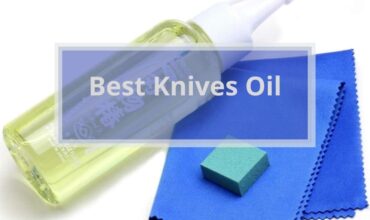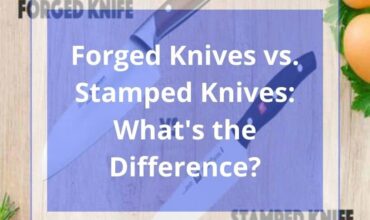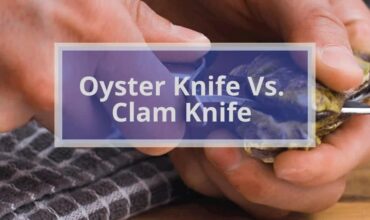Are you a fruit lover or want to feed your kids a plate of well-sliced delicious, and healthy fruits? One suitable fruit knife will be beneficial in this task. There is no need to use 2 or 3 blades and make a mess in your kitchen. A good and practical fruit knife can peel, cut, slice, garnish, core, and eliminate inedible parts. Choosing the best fruit knives can get your tasks done well and efficiently without damaging your fruit.
You are free to choose from different fruit knife types. But it’s our role to tell you which knife type can perform most of the tasks in a good way. The next part will discuss each product’s type, pros, cons, and characteristics in our recommended list.
List of Best Fruit Knives for 2025
- Bird’s beak knife (tourne knife)
- Ceramic knife
- Chef’s knife
- Paring Knife
- Utility knife
First Type, Bird Beak Knife
Bird Beak knife is also known as A tourné knife. Using this knife sheds light on one a unique and classic technique of French cuisine. They turn giant vegetables into uniform shapes of seven-sided barrels.
The knife’s main feature is its short-curved and narrow blade of 2:3 inches. Most edge angles of bird’s beak paring knives range from 14 to 18 degrees. The knife’s blade is best for peeling due to its curved part.
It can hug the curves of fruits or vegetables professionally. At the same time, the sharp tip is excellent for prep tasks such as coring and garnishing. These knives are easier to control as the shortness of this knife makes them stay closer to your hand.
| Primary uses of Beards Beak Knife | Tasks based on users’ experience |
| Useful for small tasks done off the cutting board and, in your hand | Peeling kohlrabi or celeriac |
| Make decorative cuts and garnishes | Peeling garlic, shallots, and onions |
| Peel regular and irregular shaped fruits or vegetables | Removing long citrus peels for use as seasoning or cocktail garnishes |
| Getting you a clean cut on a curved surface | |
| Cutting unwanted parts of pineapples and potatoes | Trimming brussels sprouts, artichoke stems, and asparagus stalks |
| Cutting super-close to the peel | Deveining shrimp |
| Coring strawberries and tomatoes | Peeling ginger and tomatoes |
| Slicing citrus into perfect segments | Fluting mushrooms |
| Slicing soft fruits such as nectarines, plums, or peaches |
Also check , Best Watermelon slicer | Fruit Cutters Review
Best Fruit Knives Review 2025
The bird’s beak knife blade is made of high-carbon German steel. The short and sharp edge makes it exceptional at various tasks. It’s suitable for fluting mushrooms, garnishing, small cuttings, and peeling.
The knife’s design gives you the most control while slicing. At the same time, the sharpness and hardness of the blade will make precise cuts. The knife’s excellent balance and comfort in use come from the triple-riveted handle and the tapered bolster. This knife comes in a box and has a fitted sheath to protect its blade.
- Short blade and narrow tip
- Great for detail work
- Moves smoothly around round and irregular fruits and vegetables
- Not versatile
- Doesn’t perform well with straight cuts
- Challenging to sharpen at home
- Too small for larger-handed testers
Read more , Best Knives Bags Review & Buyer’s Guide
Second Type, Ceramic Knife
The Blade of Ceramic Knives is made from zirconium oxide, also known as ceramic zirconia. This substance is very durable that is harder than stainless steel blades. Ceramic blades maintain sharp for a long time and don’t dull fast. These knives do not need regular maintenance. They don’t stain, rust, or absorb odors like steel knives. If you are looking for high-quality and low-maintenance knives, pick one of these ceramic models.
Can I use it with different kinds of food? Yes, you can. The knives’ lightweight make it easy for you to dice and slice. You can use this knife for fruits, veggies, bread, cheeses, and even cooked meat. Though, you must know that the blade of ceramic knives is rigid and not flexible as other materials. That is why they are not good with hard materials or hard textures. Try not to hit the blade or drop it by mistake on the floor, as this could chip part of the blade but will not shatter it.
Which ceramic knife type should I choose for fruits? A chef’s, utility, or paring knife will be great with fruits and veggies. We recommend the following ceramic knives’ set for your kitchen to make it easier.
| Advantages of a Ceramic Knife | Disadvantages of a Ceramic Knife |
| Extra sharp blade | Easy breakable blade |
| It stays sharp for a long time | Re-sharpening the blade requires professional skills |
| Easy to rinse clean | Rigid and not flexible blade as other materials |
| Anti-Rust | |
| Corrosion and stain resistant | |
| Lightweight | |
| Hygienic | |
| They Turn Out Super Thin Slices |
Also check , What Are The Different Types of Kitchen knives and Their Uses?
This colorful set consists of three different types of ceramic knives. A Chef’s Knife 6-inch, Utility Knife 5-inch, and Fruit Paring Knife 4-inch. Sheaths that come for each blade will protect them from cracks or chipped during storage. If you are a fan of primarily dark colors, a black handle is also available.
Suppose it’s your first time buying a ceramic knife, and you start to feel confused about the different types. This budget set will be perfect for you. Why?
A chef’s knife is the most common type; it has a bit curved tip on the end of the blade. It’s perfect for chopping and dicing fruits, vegetables, and herbs. A utility knife is the small size of a chef’s knife. It has a narrow blade that makes clean cuts. Perfect for chopping up smaller food items and making more precise cuts. A paring knife or a peeling knife has a small edge. Ideal for precise cutting, peeling, slicing, coring, and deveining.
The blades of this lovely set are sharp and maintain sharp for a long time. They resist stain and rust and don’t absorb odors like steel knives. The plastic handle gives you comfort and balance as they are very light and easy to grip. We don’t recommend a dishwasher for ceramic knives.
- Great value and affordable price
- Protective sheaths included
- Lifetime money-back guarantee
- Very sharp and easy to handle
- Not suitable for tough ingredients
- No safety features, like a rounded tip or back of the blade
- The aplastic handle may be a bit basic for certain people
Third Type, Paring knife
The type of this knife is available in different sizes and blade shapes. Most blades of these knives are straight, sharp, thin, and narrow. These blades are about three to five inches long. A paring knife is small, lightweight, and easy to handle.
This knife is dedicated to small ingredients such as shallots, garlic, or fresh herbs. It works as a good fruit and vegetable peeler. You also can use it to core, mince, and cut small food items—a large and heavy knife is not preferred for such light duties.
A paring knife has all the chef’s knife qualities but is smaller. This comfortable, sharp, solid, and inexpensive knife is one of the best paring knives.
The high-carbon stainless steel blade is perfect for garnishing, mincing, peeling, slicing, and dicing. Double ground for chopping ingredients. Sustained sharpness due to its straight edge.
The shape of the blade’s tip makes it easy to break through thick crusts or smooth peel. The high-quality material of the edges won’t discolor or corrode over time. The knife’s handle is made from a blastic solid material non-slip grip.
- Gives more specific cuts
- Durable, hygienic nylon handle
- Perfect for peeling, slicing, and dicing
- Blade won’t discolor or corrode
- Affordable price
- It may not be practical with hard veggies like carrot
- Recommend hand washing, but it’s dishwasher safe
Also read , Forged Knives vs. Stamped Knives: What’s the Difference?
Forth Type, Utility knife
A Utility knife comes in the middle between a paring knife and a chef’s knife. The blade of this small and lightweight knife is 4 to 7-inch in length. The knife’s design works with medium-sized food items. These items are considered large for a paring knife and small for a chef’s knife. A utility knife is like a paring knife; both work well for herbs, shallots, and larger pieces of garlic.
A Utility and paring knife blade is either straight or serrated. You may think that a serrated edge blade is better as it doesn’t need regular re-sharpening. Well, that is right but be aware these serrated blades become dull over time. Experts always recommend hand washing your knives, even if it’s dishwasher safe.
A Utility knife (A small size of a chef’s knife) is perfect for different kitchen tasks. The blade of this knife is made from high-grade carbon German stainless steel. This blade is anti-rust, very sharp, almost 2 mm thick, easy to re-sharpen, and clean.
The knife is suitable for almost all kinds of slicing, dicing, mincing, carving, and cutting. It goes well with different fruits, vegetables, thick sandwiches, and cheese. The knife comes in outstanding packing and is a great gift for any home or professional cook.
The balance between the unique waved pattern handle, and the thin blade ensures comfort and control while preparing your food. The handle is nice for gripping and holding. The groove in the top of the handle makes it comfortable in hand and protects your finger.
- Superb to different kinds of kitchen work
- High-grade carbon German stainless steel and anti-rust blade
- Long-lasting sharpness
- Easy re-sharpen edges
- This brand is available in different types and sizes
- Packing is in a nice gifted box
- Recommend hand washing but its dishwasher safe
- Not recommend with some kinds of meat
- A little pricey
Read more , How to Sharpen your Knives Without a Sharpener?
Fifth Type, Chef’s knife
A Chef’s knife is also known as a cook’s knife; you can almost find it in every kitchen. Lengths available for this knife are 6, 8, 10, and 12 inches. The small blade is referred to as a mini chef’s knife. In contrast, the long length is known as a traditional chef’s knife.
The blade of the chef’s knife is wide and suitable for many prep tasks. The inclination of the blade’s curve allows perfect cutting action on a chopping board. This action includes chopping and dicing lots of vegetables at once. It is suitable for cutting thick or hard foods like potatoes, sweet potatoes, onions, carrots, or radish. If you are a beginner and don’t know which chef’s knife to choose, the following one will suit you.
Wüsthof is a German company with a history dating back over 200 years. They are famous for high-quality knives with classic western designs. This German steel gives the knife balance between strength and durability.
The knife is a super multitask kitchen knife. You can use it to chop, cut, and slice different kinds of vegetables, fruits, and herbs. The sharp and anti-rust blade has a beautiful curve along the edge. It’s a full-tang blade into the triple-riveted handle with a full bolster and finger guard. This design gives you perfect balance and comfort.
The quality plastic handle is very durable and resists fading and discoloration. It’s dishwasher safe, but we recommend hand-washing to extend its lifespan.
- Sharp, strong, durable, and anti-rust blade
- Super-versatile
- Balanced and comfortable
- Handle material resist fading and discoloration
- Dishwasher-safe
- High price
FAQ
How many sides does a Tourne cut have?
This French technique cut consists of six or seven sides. You may need extra attempts to get the right shape of a mini football or a barrel.
What should you not cut with a ceramic knife?
Ceramic blades are known to be rigid or not flexible as other materials. That is why it won’t work well with tough or hard food. You also can’t use it on food with a thick and tough peel as watermelon. In general, try not to use it with veggies, fruits, or foodstuff that requires pressure while cutting it, as this could damage the blade.
What is the best knife to cut fruit?
A paring or peeling knife is suitable for cutting, peeling, slicing, and dicing fruits and vegetables. It’s a multi-task knife for different kitchen functions.
How do I choose a paring knife?
Always look for sharp tips, so cutting or slicing through small fruits and vegetables will be easy. The size of the handle and weight of the whole knife must suit your hand to make the peeling process more manageable. Finally, a balance between the blade and the handle is a must; It gives you a feeling of comfort and control while using the knife.
What foods do you cut with a utility knife?
Cut thick sandwiches
Slice tender bread types
Slice meat and herbs
Chop different fruits and vegetables
Superb to different kinds of kitchen work
What knives do chefs prefer?
Professional chefs use a chef’s knife, a paring knife, and a serrated knife for most of their tasks. A knife choice depends on the weight and balance of the grip in their hand. It’s essential to buy a knife with a blade riveted to the handle in a good way. They prefer forged and high-carbon stainless-steel knives.
How can you tell a quality knife?
A quality knife has excellent balance with lightweight while using it. They usually test the knife’s balance by putting the end of the blade on the finger, holding it horizontally, like the below image. A high-quality knife will not fall off your finger.













